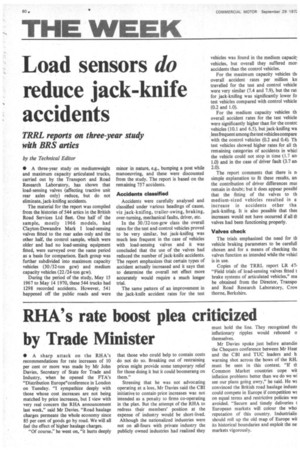Load sensors do
Page 344

If you've noticed an error in this article please click here to report it so we can fix it.
reduce jack-knife accidents
TRRL reports on three-year study with BRS artics
by the Technical Editor
• A three-year study on mediumweight and maximum capacity articulated trucks, carried out by the Transport and Road Research Laboratory, has shown that load-sensing valves (affecting tractive unit rear axles only) reduce, but do not eliminate, jack-knifing accidents.
The material for the report was compiled from the histories of 544 artics in the British Road Services Ltd fleet. One half of the sample, mostly 1966 models, had Clayton-Dewandre Mark I load-sensing valves fitted to the rear axles only and the other half, the control sample, which were older and had no load-sensing equipment fitted, were surveyed over the same period as a basis for comparison. Each group was further subdivided into maximum capacity vehicles (30 /32-ton gcw) and medium capacity vehicles (22/24-ton gcw).
During the period of the study, May 15 1967 to May 14 1970, these 544 trucks had 1298 recorded accidents. However, 541 happened off the public roads and were minor in nature, e.g., bumping a post while manoeuvring, and these were discounted from the study. The report is based on the remaining 757 accidents.
Accidents classified Accidents were carefully analysed and classified under various headings of cause, viz jack-knifing, trailer-swing, braking, over-turning, mechanical faults, driver, etc.
In the 30/32-ton-gcw class the overall rates for the test and control vehicles proved to be very similar, but jack-knifing was much less frequent in the case of vehicles with load-sensing valves and it was concluded that the use of the valves had reduced the number of jack-knife accidents. The report emphasizes that certain types of accident actually increased and it says that to determine the overall net effect more accurately would require a much longer trial.
The same pattern of an improvement in the jack-knife accident rates for the test vehicles was found in the medium capacit: vehicles, but overall they suffered moo accidents than the control vehicles.
For the maximum capacity vehicles th, overall accident rates per million kn travelled for the test and control vehicle were very similar (7.4 and 7.9), but the rat for jack-knifing was significantly lower fo test vehicles compared with control vehicle (0.2 and 1.0).
For the medium capacity vehicles th overall accident rates for the test vehicle were significantly higher than for the contrc vehicles (10.1 and 6.5), but jack-knifing wa less frequent among the test vehicles compare with the control vehicles (0.2 and 0.4). Th test vehicles showed higher rates for all th remaining categories of accidents in whicl the vehicle could not stop in time (1.7 an 1.0) and in the case of driver fault (3.7 an 2.0).
The report comments that there is n, simple explanation to fit these results, an the contribution of driver differences min remain in doubt; but it does appear possibl that the fitting of the valves to th medium-sized vehicles resulted in a increase in accidents other tha jack-knifing. It is also possible that thes increases would not have occurred if all ti valves had been functioning properly.
Valves check
The trials emphasized the need for a vehicle braking parameters to be careful] chosen and for a means of checking tin valves function as intended while the vehicl is in use.
Copies of the TRRL report LR 47, "Field trials of load-sensing valves fitted t brake systems of articulated vehicles," ma be obtained from the Director, Transpo and Road Research Laboratory, Crop thorne, Berkshire.
































































































































































































































































































































































































































































































































